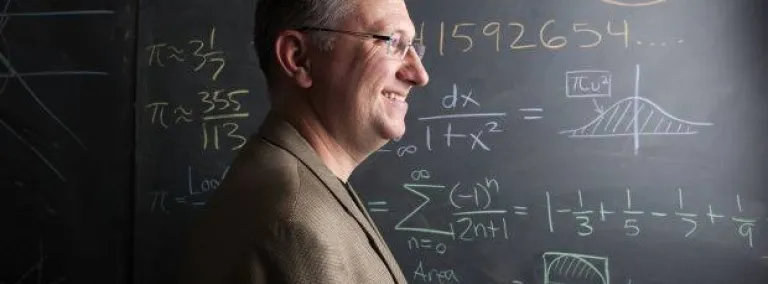An unexpected encounter with mathematics
Meet Travis Kowalski, speaker for Deep Talks: Pi Day
*Please note, this event was originally scheduled for March 2020 and was the first event Sanford Lab cancelled due to the emerging COVID-19 pandemic. This event has been rescheduled for March 11, 2021. Find full event details here.
Travis Kowalski intended to be an artist. Coming from a family of artists and having a natural talent, he enrolled as an art major at the University of California, Riverside. There, he would be introduced to a new medium—an art form and a universal language, one fashioned by various cultures over thousands of years: mathematics.
As an undergraduate, Kowalski took a calculus course to fulfill a general requirement. In this class, he encountered a curious shape called a Koch snowflake. As an artist intrigued by the interplay of shapes and design, he was surprised to discover that, although this shape had a finite area, its jagged perimeter was infinite.
“I couldn't wrap my head around that,” Kowalski remembers. “The idea that this shape could fit on a postage stamp, but there is not enough ink in the world to actually trace the edge around it.”
When the course was finished, Kowalski’s professor, Albert Stralka, suggested he take just one more mathematics course. It was in the following course, Calculus 3, that Kowalski discovered the potential of math as language.
“I realized you could use mathematics to describe every shape and form—everything from the curve of a vase to a leaf wafting through the wind,” Kowalski said. “Every pattern or line or meter could be encoded into this language.”
Stralka then encouraged Kowalski to take a course on topology, the study of geometry in motion. There, Kowalski discovered that math, the incredibly useful science that keeps boats afloat and satellites in orbit, could be appreciated for its aesthetic qualities alone.
“It's sculpture that you can do for your mind; it's poetry and music that you don't hear with your ears,” Kowalski said. “It cuts the middleman out and goes straight to the part of you who appreciates art—your mind.”
Finally, Stralka suggested a history of mathematics class. There, Kowalski discovered math as an art form influenced by countless cultures and 4,000 years of trial and error.
“Math uses symbols that every culture has contributed to: numbers from India, rules of algebra from Islamic nations, symbol sets from Latin—every culture has their hand in the symbols we write down,” Kowalski said. “Not only was math an artistic endeavor, but it was one of the very few artistic endeavors that all of humanity has contributed to.”
By the time he had completed the third mathematics class suggested by his professor, it was clear that Kowalski’s artistic trajectory had shifted.
“When I graduated, I would tell people that I hadn't changed my major, I had just changed my medium,” Kowalski said. “I was no longer in graphic design. Instead, I was creating art that you appreciate in your mind.”
Today, Kowalski is the interim head of mathematics at South Dakota School of Mines and Technology, where he creates similar encounters with his students, hoping to show them the unanticipated ways in which math intersects our daily lives.
This, he does well. In 2014, Kowalski was awarded the Benard Ennenga Award, which honors one SD Mines faculty member each year for teaching excellence; and in 2017, he won the George Polya Award from the Math Association of America for his College Mathematics Journal article, “The Sine of a Single Degree.” Kowalski was recently awarded the 2019 Burton W. Jones Award by the Mathematical Association of America.
“I wanted to do for my students what Albert Stralka did for me, to help them learn about, something they weren't expecting to, to keep their minds open to something utterly flummoxing,” Kowalski said.
This is also what he plans do at Sanford Underground Research Facility’s (Sanford Lab) March Deep Talks. To celebrate the week of Pi day, Kowalski will demonstrate the different places the number “3.14159265…” has shown up throughout history and culture.
“Pi has popped up in the Bible, in Chinese mythology, the Hindu religion and even in a parody of Edgar Allen Poe’s ‘The Raven,’” Kowalski said. “There are even hidden ways for us mere mortals to learn the digits of pi.”
Is it time you had an unexpected encounter with math? Join us for “Deep Talks: Pi Day” with Travis Kowalski. Full event details here.
